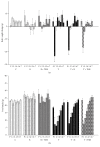Effect of Intermediate-Frequency Repetitive Transcranial Magnetic Stimulation on Recovery following Traumatic Brain Injury in Rats
- PMID: 29318150
- PMCID: PMC5727566
- DOI: 10.1155/2017/4540291
Effect of Intermediate-Frequency Repetitive Transcranial Magnetic Stimulation on Recovery following Traumatic Brain Injury in Rats
Abstract
Traumatic brain injury (TBI) represents a significant public health concern and has been associated with high rates of morbidity and mortality. Although several research groups have proposed the use of repetitive transcranial magnetic stimulation (rTMS) to enhance neuroprotection and recovery in patients with TBI, few studies have obtained sufficient evidence regarding its effects in this population. Therefore, we aimed to analyze the effect of intermediate-frequency rTMS (2 Hz) on behavioral and histological recovery following TBI in rats. Male Wistar rats were divided into six groups: three groups without TBI (no manipulation, movement restriction plus sham rTMS, and movement restriction plus rTMS) and three groups subjected to TBI (TBI only, TBI plus movement restriction and sham rTMS, and TBI plus movement restriction and rTMS). The movement restriction groups were included so that rTMS could be applied without anesthesia. Our results indicate that the restriction of movement and sham rTMS per se promotes recovery, as measured using a neurobehavioral scale, although rTMS was associated with faster and superior recovery. We also observed that TBI caused alterations in the CA1 and CA3 subregions of the hippocampus, which are partly restored by movement restriction and rTMS. Our findings indicated that movement restriction prevents damage caused by TBI and that intermediate-frequency rTMS promotes behavioral and histologic recovery after TBI.
Figures






Similar articles
-
Microglia and Astrocytes Responses Contribute to Alleviating Inflammatory Damage by Repetitive Transcranial Magnetic Stimulation in Rats with Traumatic Brain Injury.Neurochem Res. 2024 Sep;49(9):2636-2651. doi: 10.1007/s11064-024-04197-7. Epub 2024 Jun 23. Neurochem Res. 2024. PMID: 38909329
-
Effects of Repetitive Transcranial Magnetic Stimulation on Behavioral Recovery during Early Stage of Traumatic Brain Injury in Rats.J Korean Med Sci. 2015 Oct;30(10):1496-502. doi: 10.3346/jkms.2015.30.10.1496. Epub 2015 Sep 12. J Korean Med Sci. 2015. PMID: 26425049 Free PMC article.
-
Repetitive transcranial magnetic stimulation in traumatic brain injury: Evidence from animal and human studies.Brain Res Bull. 2020 Jun;159:44-52. doi: 10.1016/j.brainresbull.2020.03.016. Epub 2020 Apr 3. Brain Res Bull. 2020. PMID: 32251693 Review.
-
Seizure Risk Associated With the Use of Transcranial Magnetic Stimulation for Coma Recovery in Individuals With Disordered Consciousness After Severe Traumatic Brain Injury.J Head Trauma Rehabil. 2025 May-Jun 01;40(3):203-215. doi: 10.1097/HTR.0000000000000991. Epub 2024 Sep 5. J Head Trauma Rehabil. 2025. PMID: 39293071
-
The use of repetitive transcranial magnetic stimulation (rTMS) following traumatic brain injury (TBI): A scoping review.Neuropsychol Rehabil. 2021 Apr;31(3):479-505. doi: 10.1080/09602011.2019.1706585. Epub 2019 Dec 27. Neuropsychol Rehabil. 2021. PMID: 31880207
Cited by
-
A review of combined neuromodulation and physical therapy interventions for enhanced neurorehabilitation.Front Hum Neurosci. 2023 Jul 21;17:1151218. doi: 10.3389/fnhum.2023.1151218. eCollection 2023. Front Hum Neurosci. 2023. PMID: 37545593 Free PMC article. Review.
-
Microglia and Astrocytes Responses Contribute to Alleviating Inflammatory Damage by Repetitive Transcranial Magnetic Stimulation in Rats with Traumatic Brain Injury.Neurochem Res. 2024 Sep;49(9):2636-2651. doi: 10.1007/s11064-024-04197-7. Epub 2024 Jun 23. Neurochem Res. 2024. PMID: 38909329
-
Preliminary Observations of Personalized Repetitive Magnetic Stimulation (PrTMS) Guided by EEG Spectra for Concussion.Brain Sci. 2023 Aug 9;13(8):1179. doi: 10.3390/brainsci13081179. Brain Sci. 2023. PMID: 37626535 Free PMC article.
-
Electrical stimulation methods and protocols for the treatment of traumatic brain injury: a critical review of preclinical research.J Neuroeng Rehabil. 2023 Apr 25;20(1):51. doi: 10.1186/s12984-023-01159-y. J Neuroeng Rehabil. 2023. PMID: 37098582 Free PMC article. Review.
-
Diurnal Variation Induces Neurobehavioral and Neuropathological Differences in a Rat Model of Traumatic Brain Injury.Front Neurosci. 2020 Sep 29;14:564992. doi: 10.3389/fnins.2020.564992. eCollection 2020. Front Neurosci. 2020. PMID: 33132827 Free PMC article.
References
-
- Faul M., Wald M. M., Wu L., Coronado V. G. Traumatic brain injury in the United States : emergency department visits, hospitalizations, and deaths, 2002-2006. Centers for Disease Control and Prevention. 2010 doi: 10.15620/cdc.5571. - DOI
-
- Diaz-Arrastia R., Kochanek P. M., Bergold P., et al. Pharmacotherapy of traumatic brain injury: State of the science and the road forward: Report of the department of defense neurotrauma pharmacology workgroup. Journal of Neurotrauma. 2014;31(2):135–158. doi: 10.1089/neu.2013.3019. - DOI - PMC - PubMed
MeSH terms
LinkOut - more resources
Full Text Sources
Other Literature Sources
Medical
Miscellaneous

